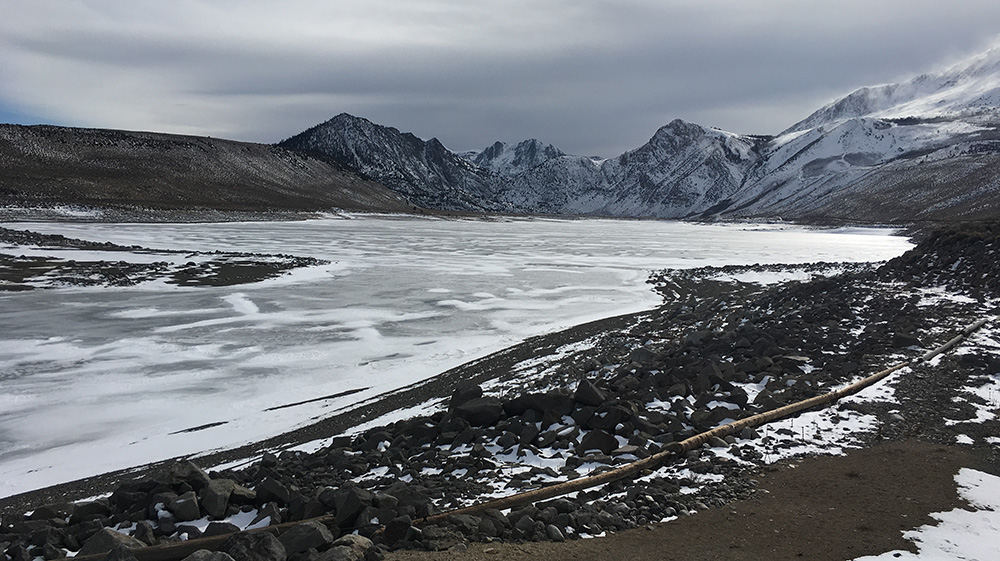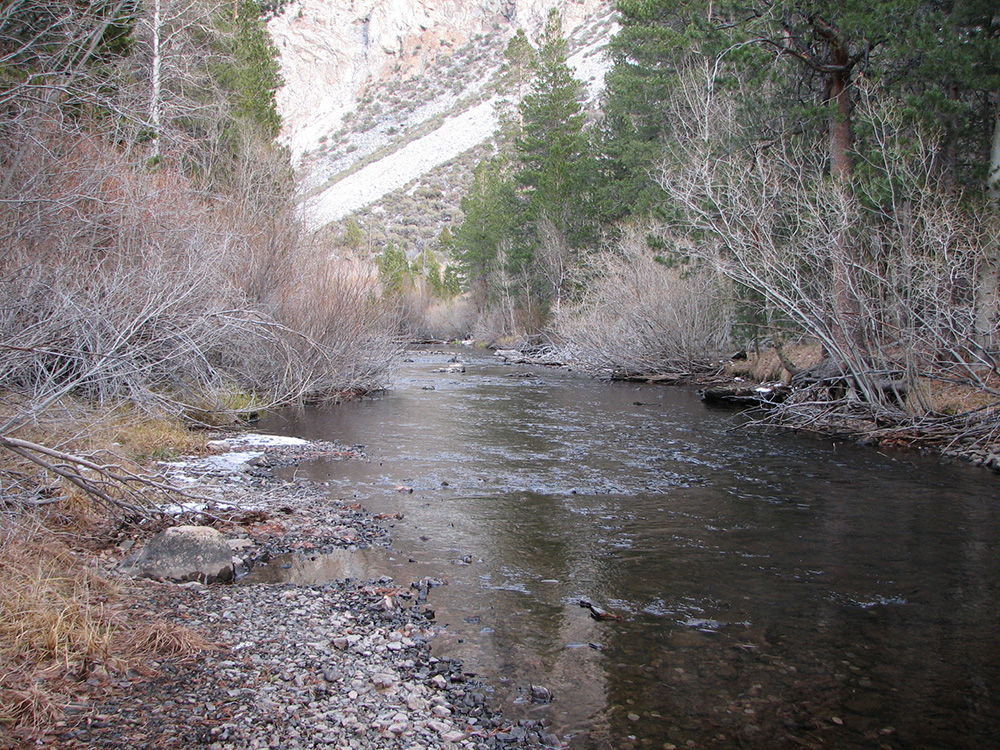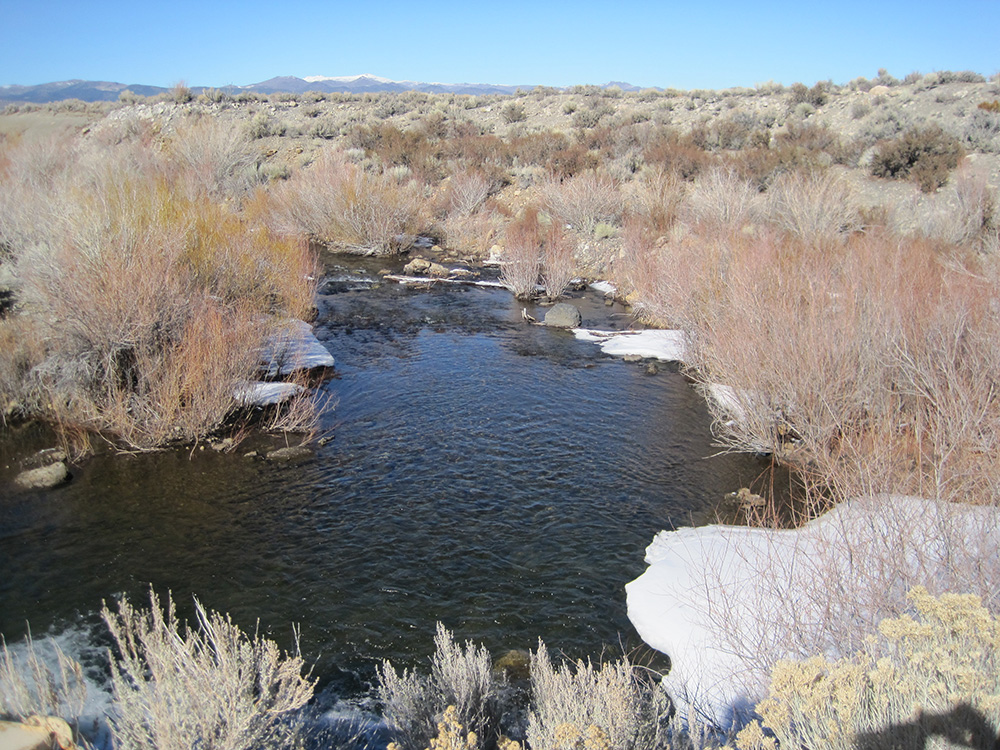
This post was written by Lisa Cutting, 2002-2020 Eastern Sierra Policy Director, 2000-2001 Environmental Resource Coordinator, and 1999 Mono Lake Intern.
Despite some snow on the peaks and forecasters still calling for an El Niño weather pattern, Grant Lake Reservoir remains at a precariously low level. With three Southern California Edison (SCE) reservoirs upstream, and four years of drought to catch up from, Grant will be the last reservoir to benefit from this year’s runoff. Since lower Rush Creek is dependent on Grant Lake Reservoir for its water, and because special water management rules are triggered when Grant drops to a certain level, the Mono Lake Committee was busy in December ensuring that the best possible situation was secured for Rush Creek for the remainder of the winter.

Grant can only go so low
In 1994, the California State Water Resources Control Board, by way of Decision 1631, had the foresight to protect flows in Rush Creek from scenarios in which Grant Lake Reservoir gets abnormally low. Ordinarily, the minimum winter release requirement from Grant to lower Rush Creek is 36 cubic feet per second (cfs). However, the rule states, “If Grant Lake storage falls below 11,500 acre-feet, the instream flow requirement shall be the lesser of the inflow to Grant Lake from Rush Creek or the specified dry year flow requirement.” This change in operation acts as a safety mechanism to prevent Grant from reaching a level so low that releasing water into Rush Creek would be physically impossible.
Last fall Committee staff projected that Grant could reach 11,500 acre-feet by late November (see Fall 2015 Mono Lake Newsletter). By early December it was clear that the low-volume rule would be triggered—but the situation wasn’t that simple.
Over the last two years, SCE has been releasing upstream flows in a “peaking” pattern where more water is released at times of peak electricity need. This means that the amount of water flowing into Grant can fluctuate daily between 10 cfs and 100 cfs, making it difficult to match the outflow with the inflow.
Furthermore, as Grant fluctuates above and below 11,500 acre-feet, the required flows would also fluctuate anywhere from 10 cfs to 36 cfs. Fluctuations in Grant’s level pose the greater problem—both in terms of acceptable winter flows for the health of Rush Creek and for DWP’s operations.
Special permission necessary
Fortunately, the State Water Board offers a remedy for special circumstances like this: A “Temporary Urgency Change Petition” (TUCP) can be filed by the licensee. In this case, all the parties involved—DWP, the Committee, California Trout, California Fish & Wildlife, and the State Water Board-appointed Stream Scientists—supported a TUCP.
Two primary and related factors emerged as justification for the TUCP. First, a release of 10 cfs (the most recent low inflow from SCE’s hydropower plant) is much lower than the 25 cfs minimum winter flow set forth in the 2013 Mono Basin Stream Restoration Agreement. Even though the Agreement is still awaiting adoption by the State Water Board, the supporting science for that winter base flow has long been vetted and agreed upon. Additionally, 10 cfs would be well below the lowest flow studied by the Stream Scientists during the 2009 Instream Flow Study. During that study the lowest flow analyzed was 15 cfs, which was determined to be too low and detrimental to the health of Rush Creek with the current habitat conditions.
Second, adhering to the minimum release requirement for when the reservoir is below 11,500 acre-feet would cause the reservoir to fluctuate around that level, causing releases to Rush Creek to fluctuate between as low as 10 cfs (when the reservoir is below 11,500 acre-feet) and 36 cfs (when the reservoir is above 11,500 acre-feet). This large and frequent fluctuation occurring in winter is not good for trout health and survival, stressing the already drought-affected fishery.
The TUCP requested approval to release a consistent flow of 20 cfs—regardless of whether Grant Lake Reservoir is above or below 11,500 acre-feet—until March 31, 2016, when the temporary change expires. The 20 cfs flow was the best option for both maintaining the health of trout in winter and also preserving water storage in Grant Lake Reservoir. DWP submitted the TUCP in mid-December and a month later it was approved by the State Water Board.
The Stream Scientists have identified ideal winter base flows for Rush Creek to be 25–29 cfs. Flows higher than this adversely affect trout—making them expend extra energy to work against the stronger current during the winter when food is scarce. Once the Mono Basin Stream Restoration Agreement is approved by the State Water Board, the range of winter flows in Rush Creek will be clearly specified at the optimum level conducive to trout health and other aspects of stream restoration.

Restoration recovery = resilience
Some readers may be wondering why low winter flows are such a big deal. Many creeks in the Eastern Sierra have low water levels in winter—including Rush Creek above Grant Lake Reservoir—especially after four years of drought. The answer is that even though Rush Creek has experienced tremendous restoration recovery, the system still has a ways to go. Many of the steps are related to trout habitat complexity—like the creation of deep pools and overhanging vegetation that offer cover from predators in winter when water levels are low. Deep pools are less likely to completely freeze, and therefore provide refuge from cold, icy conditions of shallower water when every degree counts in terms of trout survival.

Comparing lower Rush Creek (below Grant) with upper Rush Creek (between Silver Lake and Grant Lake Reservoir) shows a stark contrast. Upper Rush Creek was never fully diverted and the habitat is diverse and complex—deep pools, large fallen trees across the creek, and a variety of streamside vegetation help trout weather low flows and temperatures. Lower Rush Creek will get there eventually but it isn’t there yet, so actions like the TUCP that help mimic natural stream patterns as closely as possible are critical.
The Mono Lake Committee will always be here to advocate for the streams to get the water they need, no matter how complicated negotiations become. However, the 2013 Mono Basin Stream Restoration Agreement sets up a simplified process shaped by the most current scientific analysis to ensure the best flows at all times. The sooner the Stream Restoration Agreement is in place, the more streamlined the process for dealing with these complicated scenarios will be.
This post was also published as an article in the Winter & Spring 2016 Mono Lake Newsletter (pages 5 and 17).
